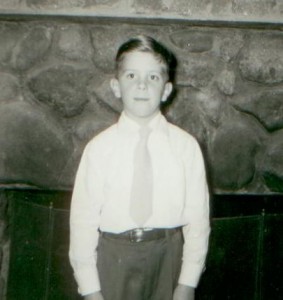
The shy David Palmer
I was a mama’s boy. The youngest of four males born to my parents within five years, I was the baby of the family and spoiled rotten. There are a number of family stories dramatizing that fact, my favorite of which is how I bravely got on the school bus for my first day in kindergarten only to run screaming down the aisle for my mother the moment the doors closed. I did get chauffeured to school that day but still the teacher had to peel me off my mother’s leg while firmly assuring Mom that I would be all right.
And, eventually, I was. The next day, and every subsequent day, I couldn’t wait to get on the bus. However, I remained a sometimes painfully shy kid until I graduated from high school and was living on my own making my own way in the world. I managed my shy nature with loving support and (mostly) outgrew it with self-sufficiency and self-awareness.
Today shy kids are diagnosed with “social anxiety disorder” and given Paxil or other medication. Our contemporary culture has a well-documented tendency to turn every cursory personal quirk into a disease that needs treatment. While I am certain that there are a few shy folk, overweight people, fidgety kids and existentially troubled adults who could benefit from a prescription, I harbor the sneaking suspicion that: a) these are symptoms of a cultural disorder, not a personal one, and b) that it only benefits the pharmaceutical companies to encourage us to believe that the reverse is true.
 I was thinking of this tendency to pathologize life as I was re-reading an article by Virginia Postrel analyzing the massage industry. Ms. Postrel is a journalist who focuses on the intersection of culture and commerce. She has been a reporter for Inc. and The Wall Street Journal as well as a columnist for The New York Times and The Atlantic Monthly. She has also authored two books, The Future and Its Enemies and The Substance of Style about how cultural trends become commercial enterprises.
I was thinking of this tendency to pathologize life as I was re-reading an article by Virginia Postrel analyzing the massage industry. Ms. Postrel is a journalist who focuses on the intersection of culture and commerce. She has been a reporter for Inc. and The Wall Street Journal as well as a columnist for The New York Times and The Atlantic Monthly. She has also authored two books, The Future and Its Enemies and The Substance of Style about how cultural trends become commercial enterprises.
One of her columns from The Atlantic Monthly contained an insightful outsider’s critique of the massage industry tracing its history from the strip club to the strip mall. Below is a lengthy excerpt from the original piece published in The Atlantic.
As a business, massage has two basic problems. The first is that prostitution is generally illegal. A brothel can’t openly advertise its services: no “Madame Julia’s House of Great Sex.” Instead, Madame Julia pretends she runs a “massage parlor,” which creates confusion, and sometimes legal obstacles, for people who want to buy and sell back rubs.
The second problem is that most potential customers consider massage a luxury—an optional indulgence, if not a slightly shameful extravagance. So they’re acutely sensitive to price. A massage business can’t pass high labor costs along to consumers without suffering a rapid drop in sales.
One way to attack these problems is to declare massage a medical service. Hence in 1983 the American Massage & Therapy Association dropped its ampersand to create a new profession: “massage therapy.” Customers and legal authorities can be pretty sure—though not 100 percent certain—that a massage therapist isn’t selling sex. A therapist not only will keep the client discreetly draped with a sheet but also will take a reassuringly clinical approach to kneading naked flesh. A masseuse, on the other hand, may well be a hooker in a skimpy disguise.
Calling massage a “therapy” also suggests that it’s good for you, which means you don’t have to feel guilty about spending money on it. You might even be able to pass the bill on to your insurance company (only rarely, so far). Massage therapists understandably want their clients to think of massage as a necessity. “At one point in my career I had to defend massage against the ‘prostitution attitude,’” says Brenda L. Griffith, a massage therapist in Richmond, Virginia, who has been practicing since 1988. “Now I have to defend massage against the ‘pampering attitude.’” Many of her clients do, in fact, have chronic ailments for which massage offers some relief.
But relentlessly touting the healing power of touch makes too many massage therapists sound like quacks. The medical strategy also treats clients as patients, eliminating potential customers who feel healthy. It attracts clients by turning everyday life into a disease. Who, after all, doesn’t suffer from stress? Like graphic and industrial designers who refuse to talk about aesthetics, massage therapists seem embarrassed to say they make people feel good.
As something of a massage addict, I don’t buy the medical line, and I don’t think it’s necessary. Assuming it’s not too vigorous, a massage not only feels good but also helps me think. It’s relaxing, but not so relaxing that I fall asleep. Like a nice glass of wine with dinner or an all-white Heavenly Bed in a hotel room, a massage break adds a little pleasure to everyday life. Even if the massage does nothing for my health, I consider the money well spent.
Humans are sensory beings. Massage doesn’t need to justify pleasing our muscles and skin any more than music has to justify pleasing our ears. Chefs don’t have to call themselves “nutritional therapists.” Hairstylists don’t have to pretend that gray hair is a disease. Enjoyment is a perfectly fine reason to get a massage.
I love that last line. Why is it that people feel they are not allowed to get a massage unless something is wrong? In our quest to distance ourselves from a shady past have we turned massage into purely a medical treatment? Have we trained the public to see massage as being required only when we have something amiss in our soul, psyche or somatic self?
When I ran a retail chair massage studio, I noticed that virtually all new customers felt obligated to justify their visit with a medical complaint such as a crick in their neck, a headache or a sore back or shoulders. At the end of their visit, either their problem is resolved, or not, so regardless of the outcome, there is little motivation for them to return unless we take the time to reeducate them away from the point of view that there has to be something wrong before they can get a massage.
Interestingly, at the time the article was published in 2006 it provoked a harsh reaction from the American Massage Therapy Association. The president at the time, Mary Beth Braun, wrote a letter of complaint to the magazine accusing Postrel both of connecting massage to prostitution and implying that massage is only to make people feel good.
Setting aside the fact that both charges are a gross misreading of the article, what exactly is the problem with “feeling good” being the foundation of massage? Wouldn’t it be a major contribution to society if the primary focus of massage was to make people feel good? It just might even be a non-pharmaceutical solution to “social anxiety disorder.” [And, for more on why a strong mother-son bond is crucial, check out this great article.]
Do you think “feeling good” is a legitimate goal for massage? Have we overemphasized the need to define massage as “therapy?” Your comments below are welcome.




Great discourse. I think that “feeling good” is a great reason to get massage. We should be careful with the term “therapy.” Therapy can be a laugh, a hug, talk therapy, medication, etc. It’s a vague term that is supposed to denote an expert gives it. Make it an umbrella term.
There is a similar argument with “medical marijuana.”. Many consider it’s use as recreational or medical. Others say all use is medical. Hmmm.
How about “recreational” massage?
Jody
Thank you, thank you!
Ever since massage school, I have been getting the message that Swedish massage (and what is that really? who does traditional Swedish? we all mix it up,) is not enough. You are only a “really good” massage therapist if you do clinical massage and specialize in treating conditions. Someone once told me that his son was in massage school, and that the more the son learned, the less the father enjoyed the massages. As I was reading your article, I remembered what I put on my website home page: “What is the best reason to get a massage?”
“Because it feels good.” (with implied “Duhh”)
Thank you for helping me boost my professional self-esteem.
One more thought: I often tell people that everyone should massage their loved ones.
If everyone got a daily neck and shoulder rub, the world would be a much happier place.
Thanks for your comments Jody and Karen.
If I could reinvent the industry, the primary goal of massage schools would be to teach students how to give and receive positive touch that “just” made people feel better. The secondary goal would be to give graduates the training to be touch educators for the general public so that they could teach the value and the skills of simple touch in schools, in the workplace, in senior centers, in churches and everywhere in between.
Teaching parents infant massage, friends and family members hand massages and hospice workers compassionate touch, for example, would have far more impact on the quality of life of humanity, as well as the employ-ability of massage school graduates, than any massage therapy course. Most people do not need an ambulance. They need a guard rail.
The most important role of the massage profession is to be the home of cultural expertise around the sense of touch. There is no other profession that so obviously has that responsibility. That is my call to arms…er, make that hands.
Pingback: How Culture Mediates Massage | |